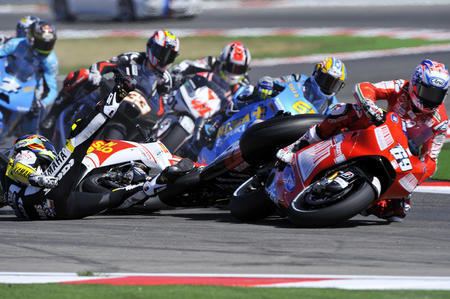Start date 2009 | ||
 | ||
Similar 2008 Grand Prix motorcycl, 2010 Grand Prix motorcycl, 2007 Grand Prix motorcycl, 2006 Grand Prix motorcycl, 2005 Grand Prix motorcycl | ||
The 2009 Grand Prix motorcycle racing season was the 61st F.I.M. Road Racing World Championship season. Valentino Rossi won his sixth MotoGP title, seventh in the top class and ninth title in total after getting the better of team-mate Jorge Lorenzo in a season-long battle. In the final 250cc championship (it was replaced by the Moto2 class in 2010), Hiroshi Aoyama became the third Japanese rider to win that title, after Tetsuya Harada and Daijiro Kato. In the 125cc class, Julián Simón won the title after taking seven victories during the season.
Contents
- Cost cutting measures
- Kawasaki withdrawal and return
- 2009 Grand Prix season calendar
- Scoring system
- Riders standings
- 250cc
- 125cc
- MotoGP manufacturers standings
- 125cc manufacturers standings
- Participants
- MotoGP participants
- 250cc participants
- 125cc participants
- References
The MotoGP season was marked by dominance by the Yamaha duo Rossi and Lorenzo, with occasional wins for Dani Pedrosa and Casey Stoner. Riding the factory Ducati, 2007 champion Stoner won the opener in Qatar as well as a rain-hit race in Italy to open up a championship lead after six rounds. Inconsistent handling from the Ducati as well as health problems for Stoner causing fatigue saw him drop out of the title fight by mid-season, whereas Pedrosa and Lorenzo crashed more often than Rossi who built up a sizeable lead to win the title.
Cost-cutting measures
As announced during 2008, MotoGP class switched to a single-tyre manufacturer. The move was made to try to improve safety by reducing cornering speeds, and in a marginal way for cost reasons; the winner was decided by bid. Michelin, one of the two tyre suppliers in 2008, decided not to bid for the supply, effectively declaring Bridgestone the winner, which was confirmed on 18 October 2008. Bridgestone will be the sole tyre supplier from 2009 to 2011. Only race spec tyres will be provided to the teams, eliminating qualifying tyres, in use until 2008.
Other cost-cutting manoeuvers were made during the winter prior to the season, to try to contain the rising costs of the sport, especially during a period of economic downturn. FIM was especially concerned, fearing that defections among private and factory teams could leave the grid with 14 bikes only.
After negotiations between FIM, Dorna and MSMA (the manufacturers' association), new measures were adopted. The Friday morning free practice session was eliminated, limiting the Friday practice time to a single 45-minute session (later brought to a 1-hour session from the French GP onwards); a limit of 5 engines was imposed for the last 7 races, with a 10-point penalty for each additional engine used; ceramic composite materials for brakes were banned; electronic assistance was reduced with the ban of electronic controlled suspensions and launch control systems; Monday tests will be cancelled except for Catalunya and Brno, where only test riders will be allowed to take part.
Kawasaki withdrawal and return
With a somewhat unexpected announcement, Kawasaki made public its intention to withdraw from MotoGP immediately on 9 January 2009, citing the global economic downturn as the main cause of the decision. Initial negotiations between Dorna and Kawasaki aimed to run the two bikes with the private Aspar team, but after further talks, on 26 February 2009 Kawasaki announced its decision to remain in the category, running a single bike team with Marco Melandri, effectively leaving John Hopkins without a contract. The team ran under the Hayate Racing banner, as announced on 1 March 2009.
2009 Grand Prix season calendar
The 2009 revised race schedule was released on 24 October 2008. A Hungarian round was originally scheduled for 20 September 2009 but the organizers asked Dorna to postpone the event to 2010 due to delays in the construction of the Balatonring circuit.
Due to adverse weather conditions, the Qatar MotoGP race was postponed until 13 April.
‡ = Night RaceScoring system
Points are awarded to the top fifteen finishers. Rider has to finish the race to earn points.
Riders' standings
250cc
250cc wildcard and replacement riders results
125cc
† Half-points awarded in Qatar, as the riders did not complete the sufficient distance for full points.
125cc wildcard and replacement riders results
MotoGP manufacturers standings
† Following Loris Capirossi's engine change, Suzuki was given a ten-point penalty in the constructors' championship at the Australian Grand Prix because of the new for 2009 MotoGP engine change limit rule which restricts each rider to five engines for the final seven rounds.
125cc manufacturers standings
† Half-points awarded in Qatar, as the riders did not complete the sufficient distance for full points.
Participants
All entries taken from the official MotoGP site.
MotoGP participants
^All entries use Bridgestone tires.
Note 1: Mika Kallio replaced Casey Stoner in Czech GP, Indianapolis GP and San Marino GP.
Note 2: Michel Fabrizio replaced Mika Kallio in Czech GP.
Note 3: Aleix Espargaró replaced Mika Kallio in Indianapolis GP and San Marino GP. He also replaced Niccolò Canepa in Malaysian GP and Valencian GP.
